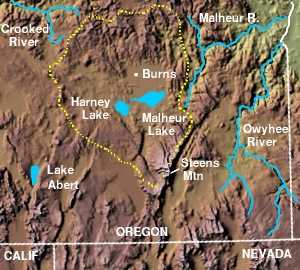Timeline of volcanism on Earth
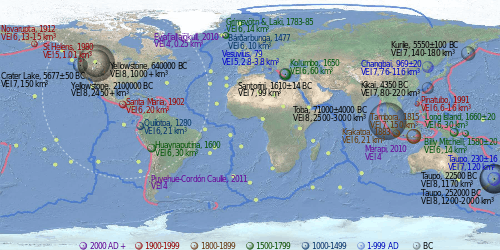
This timeline of volcanism on Earth is a list of major volcanic eruptions of approximately at least magnitude 6 on the Volcanic Explosivity Index (VEI) or equivalent sulfur dioxide emission around the Quaternary period. Some cooled the global climate; the extent of this effect depends on the amount of sulfur dioxide emitted.[1][2] The topic in the background is an overview of the VEI and sulfur dioxide emission/ Volcanic winter relationship. Before the Holocene epoch the criteria are less strict because of scarce data availability, partly since later eruptions have destroyed the evidence. So, the known large eruptions after the Paleogene period are listed, and especially those relating to the Yellowstone hotspot, the Santorini, and the Taupo Volcanic Zone. Only some eruptions before the Neogene period are listed. Active volcanoes such as Stromboli, Mount Etna and Kilauea do not appear on this list, but some back-arc basin volcanoes that generated calderas do appear. Some dangerous volcanoes in "populated areas" appear many times: so Santorini, six times and Yellowstone hotspot, twenty-one times. The Bismarck volcanic arc, New Britain and the Taupo Volcanic Zone, New Zealand appear often too.
In order to keep the list manageable, the eruptions in the Holocene on the link: Holocene Volcanoes in Kamchatka aren't yet added, but they are listed in Peter L. Ward's supplemental table.[3]
Large Quaternary eruptions
The Holocene epoch begins 11,700 years BP,[4] (10 000 14C years ago)
Since 1000 AD
- Pinatubo, island of Luzon, Philippines; 1991, June 15; VEI 6; 6 to 16 km3 (1.4 to 3.8 cu mi) of tephra;[5] an estimated 20,000,000 tonnes (22,000,000 short tons) of SO
2 were emitted[1] - Novarupta, Alaska Peninsula; 1912, June 6; VEI 6; 13 to 15 km3 (3.1 to 3.6 cu mi) of lava[6][7][8]
- Santa Maria, Guatemala; 1902, October 24; VEI 6; 20 km3 (4.8 cu mi) of tephra[9]
- Krakatoa, Indonesia; 1883, August 26–27; VEI 6; 21 km3 (5.0 cu mi) of tephra[10]
- Mount Tambora, Lesser Sunda Islands, Indonesia; 1815, Apr 10; VEI 7; 150 km3 (36 cu mi) of tephra;[5] an estimated 200,000,000 t (220,000,000 short tons) of SO
2 were emitted, produced the "Year Without a Summer"[11] - The "Mysterious 1810 Event" VEI 6.5; discovered from ice cores in the 1980s.[12]
- Grímsvötn, Northeastern Iceland; 1783–1785; Laki; 1783–1784; VEI 6; 14 km3 (3.4 cu mi) of lava, an estimated 120,000,000 t (130,000,000 short tons) of SO
2 were emitted, produced a Volcanic winter, 1783, on the North Hemisphere.[13] - Long Island (Papua New Guinea), Northeast of New Guinea; 1660 ±20; VEI 6; 30 km3 (7.2 cu mi) of tephra[5]
- Kolumbo, Santorini, Greece; 1650, September 27; VEI 5; 2 km3 (0.5 cu mi) of tephra[14]
- Huaynaputina, Peru; 1600, February 19; VEI 6; 30 km3 (7.2 cu mi) of tephra[15]
- Billy Mitchell, Bougainville Island, Papua New Guinea; 1580 ±20; VEI 6; 14 km3 (3.4 cu mi) of tephra[5]
- Bárðarbunga, Northeastern Iceland; 1477; VEI 6; 10 cubic kilometres (2.4 cu mi) of tephra[5]
- 1452-53 New Hebrides arc, Vanuatu; the location of this eruption in the South Pacific is uncertain, as it has been identified from distant ice core records; the only pyroclastic flows are found at Kuwae; 36 to 96 km3 (8.6 to 23.0 cu mi) of tephra; 175,000,000–700,000,000 t (193,000,000–772,000,000 short tons) of sulfuric acid[16][17][18]
- Quilotoa, Ecuador; 1280(?); VEI 6; 21 km3 (5.0 cu mi) of tephra[5]
- Samalas volcano, Rinjani Volcanic Complex, Lombok Island, Indonesia; 1257; 40 km3 (dense-rock equivalent) of tephra, Arctic and Antarctic Ice cores provide compelling evidence to link the ice core sulfate spike of 1258/1259 A.D. to this volcano.[19][20]
Overview of Common Era
This is a sortable summary of major eruptions over the last 2000 years with VEI 6+ (but including the notable VEI 5 eruptions of Mount St. Helens, Mount Tarawera and Mount Vesuvius). Date uncertainties, tephra volumes, and references are not included.
| Caldera/ Eruption name | Volcanic arc/ belt or Subregion or Hotspot | VEI | Date | Known/proposed consequences |
|---|---|---|---|---|
| Mount Pinatubo | Luzon Volcanic Arc | 6 | 1991, Jun 15 | Global temperature fell by 0.4 °C |
| Mount St. Helens | Cascade Volcanic Arc | 5 | 1980, May 18 | |
| Novarupta | Aleutian Range | 6 | 1912, Jun 6 | |
| Santa María | Central America Volcanic Arc | 6 | 1902, Oct 24 | |
| Mount Tarawera | Taupo Volcanic Zone | 5 | 1886, Jun-Aug | Destruction of the Pink and White Terraces, which were nicknamed the '8th wonder of the natural world'. |
| Krakatoa | Sunda Arc | 6 | 1883, Aug 26–27 | At least 30,000 dead |
| Mount Tambora | Lesser Sunda Islands | 7 | 1815, Apr 10 | Year Without a Summer (1816) |
| Grímsvötn and Laki | Iceland | 6 | 1783-85 | Mist Hardships |
| Long Island (Papua New Guinea) | Bismarck Volcanic Arc | 6 | 1660 | |
| Kolumbo, Santorini | South Aegean Volcanic Arc | 5 | 1650, Sep 27 | |
| Huaynaputina | Andes, Central Volcanic Zone | 6 | 1600, Feb 19 | Russian famine of 1601–1603 |
| Billy Mitchell | Bougainville & Solomon Is. | 6 | 1580 | |
| Bárðarbunga | Iceland | 6 | 1477 | |
| Kuwae | New Hebrides Arc | 6 | 1452-53 | 2nd pulse[21] of Little Ice Age? |
| Quilotoa | Andes, Northern Volcanic Zone | 6 | 1280 | |
| Samalas (Mount Rinjani) | Lombok, Lesser Sunda Islands | 6 | 1257 | 1st pulse[22][23] of Little Ice Age? (c.1250) |
| Baekdu Mountain/Tianchi eruption | China/ North Korea border | 7 | 949 (±3),[24] or 969 (±20) | Limited regional climatic effects.[25] |
| Katla/Eldgjá eruption | Iceland | 6 | 934-940 | |
| Ceboruco | Trans-Mexican Volcanic Belt | 6 | 930 | |
| Dakataua | Bismarck Volcanic Arc | 6 | 800 | |
| Pago | Bismarck Volcanic Arc | 6 | 710 | |
| Mount Churchill | eastern Alaska, USA | 6 | 700 | |
| Rabaul Caldera | Bismarck Volcanic Arc | 6 | 540 (est.) | Extreme weather events of 535–536 |
| Ilopango | Central America Volcanic Arc | 6 | 450 | |
| Ksudach | Kamchatka Peninsula | 6 | 240 | |
| Taupo Caldera/Hatepe eruption | Taupo Volcano | 7 | 180 or 230 | Affected skies over Rome and China |
| Mount Vesuvius/Pompeii eruption | Italy | 5 | 79 | |
| Mount Churchill | eastern Alaska, USA | 6 | 60 | |
| Ambrym | New Hebrides Arc | 6 | 50 | |
| Apoyeque | Central America Volcanic Arc | 6 | 50 BC | |
Note: Caldera names tend to change over time. For example, Okataina Caldera, Haroharo Caldera, Haroharo volcanic complex, Tarawera volcanic complex had the same magma source in the Taupo Volcanic Zone. Yellowstone Caldera, Henry's Fork Caldera, Island Park Caldera, Heise Volcanic Field had all Yellowstone hotspot as magma source.
Earlier Quaternary eruptions
2.588 ± 0.005 million years BP, the Quaternary period and Pleistocene epoch begin.
- Eifel hotspot, Laacher See, Vulkan Eifel, Germany; 12.9 ka; VEI 6; 6 cubic kilometers (1.4 cu mi) of tephra.[26][27][28][29]
- Emmons Lake Caldera (size: 11 x 18 km), Aleutian Range, 17 ka ±5; more than 50 km3 (12 cu mi) of tephra.[3]
- Lake Barrine, Atherton Tableland, North Queensland, Australia; was formed over 17 ka.
- Menengai, East African Rift, Kenya; 29 ka[5]
- Morne Diablotins, Commonwealth of Dominica; VEI 6; 30 ka (Grand Savanne Ignimbrite).[30]
- Kurile Lake, Kamchatka Peninsula, Russia; Golygin eruption; about 41.5 ka; VEI 7[5]
- Maninjau Caldera (size: 20 x 8 km), West Sumatra; VEI 7; around 52 ka; 220 to 250 cubic kilometers (52.8 to 60.0 cu mi) of tephra.[31]
- Lake Toba (size: 100 x 30 km), Sumatra, Indonesia; VEI 8; 73 ka ±4; 2,500 to 3,000 cubic kilometers (599.8 to 719.7 cu mi) of tephra; probably six gigatons of sulfur dioxide were emitted (Youngest Toba Tuff).[1][32][33][34][35]
- Atitlán Caldera (size: 17 x 20 km), Guatemalan Highlands; Los Chocoyos eruption; formed in an eruption 84 ka; VEI 7; 300 km3 (72 cu mi) of tephra.[36]
- Mount Aso (size: 24 km wide), island of Kyūshū, Japan; 90 ka; last eruption was more than 600 cubic kilometers (144 cu mi) of tephra.[3][37]
- Sierra La Primavera volcanic complex (size: 11 km wide), Guadalajara, Jalisco, Mexico; 95 ka; 20 cubic kilometers (5 cu mi) of Tala Tuff.[3][38]
- Mount Aso (size: 24 km wide), island of Kyūshū, Japan; 120 ka; 80 km3 (19 cu mi) of tephra.[3]
- Mount Aso (size: 24 km wide), island of Kyūshū, Japan; 140 ka; 80 km3 (19 cu mi) of tephra.[3]
- Puy de Sancy, Massif Central, central France; it is part of an ancient stratovolcano which has been inactive for about 220,000 years.
- Emmons Lake Caldera (size: 11 x 18 km), Aleutian Range, 233 ka; more than 50 km3 (12 cu mi) of tephra.[3]
- Mount Aso (size: 24 km wide), island of Kyūshū, Japan; caldera formed as a result of four huge caldera eruptions; 270 ka; 80 cubic kilometers (19 cu mi) of tephra.[3]
- Uzon-Geyzernaya calderas (size: 9 x 18 km), Kamchatka Peninsula, Russia; 325-175 ka[39] 20 km3 (4.8 cu mi) of ignimbrite deposits.[40]
- Diamante Caldera–Maipo volcano complex (size: 20 x 16 km), Argentina-Chile; 450 ka; 450 cubic kilometers (108 cu mi) of tephra.[3][41]
- Yellowstone hotspot; Yellowstone Caldera (size: 45 x 85 km); 640 ka; VEI 8; more than 1,000 cubic kilometers (240 cu mi) of tephra (Lava Creek Tuff)[5]
- Three Sisters (Oregon), USA; Tumalo volcanic center; with eruptions from 600 - 700 to 170 ka years ago
- Uinkaret volcanic field, Arizona, USA; the Colorado River was dammed by lava flows multiple times from 725 to 100 ka.[42]
- Mono County, California, USA; Long Valley Caldera; 758.9 ka ±1.8; VEI 7; 600 cubic kilometers (144 cu mi) of Bishop Tuff.[3][43]
- Valles Caldera, New Mexico, USA; around 1.15 Ma; VEI 7; around 600 cubic kilometers (144 cu mi) of the Tshirege formation, Upper Bandelier eruption.[3][44][45]
- Sutter Buttes, Central Valley of California, USA; were formed over 1.5 Ma by a now-extinct volcano.
- Ebisutoge-Fukuda tephras, Japan; 1.75 Ma; 380 to 490 cubic kilometers (91.2 to 117.6 cu mi) of tephra.[3]
- Yellowstone hotspot; Island Park Caldera (size: 100 x 50 km); 2.1 Ma; VEI 8; 2,450 cubic kilometers (588 cu mi) of Huckleberry Ridge Tuff.[3][5]
- Cerro Galán (size: 32 km wide), Catamarca Province, northwestern Argentina; 2.2 Ma; VEI 8; 1,050 cubic kilometers (252 cu mi) of Cerro Galán Ignimbrite.[46]
Large Neogene eruptions
Pliocene eruptions
Approximately 5.332 million years BP, the Pliocene epoch begins. Most eruptions before the Quaternary period have an unknown VEI.

Volcanism locations.


- Boring Lava Field, Boring, Oregon, USA; the zone became active at least 2.7 Ma, and has been extinct for about 300,000 years.[47]
- Norfolk Island, Australia; remnant of a basaltic volcano active around 2.3 to 3 Ma.[48]
- Pastos Grandes Caldera (size: 40 x 50 km), Altiplano-Puna Volcanic Complex, Bolivia; 2.9 Ma; VEI 7; more than 820 cubic kilometers (197 cu mi) of Pastos Grandes Ignimbrite.[49]
- Little Barrier Island, northeastern coast of New Zealand's North Island; it erupted from 1 million to 3 Ma.[50]
- Mount Kenya; a stratovolcano created approximately 3 Ma after the opening of the East African rift.[51]
- Pacana Caldera (size: 60 x 35 km), Altiplano-Puna Volcanic Complex, northern Chile; 4 Ma; VEI 8; 2,500 cubic kilometers (600 cu mi) of Atana Ignimbrite.[52]
- Frailes Plateau, Bolivia; 4 Ma; 620 cubic kilometers (149 cu mi) of Frailes Ignimbrite E.[3][53]
- Cerro Galán (size: 32 km wide), Catamarca Province, northwestern Argentina; 4.2 Ma; 510 cubic kilometers (122 cu mi) of Real Grande and Cueva Negra tephra.[3]
- Yellowstone hotspot, Heise volcanic field, Idaho; Kilgore Caldera (size: 80 x 60 km); VEI 8; 1,800 cubic kilometers (432 cu mi) of Kilgore Tuff; 4.45 Ma ±0.05.[3][54]
- Khari Khari Caldera, Frailes Plateau, Bolivia; 5 Ma; 470 cubic kilometers (113 cu mi) of tephra.[3]
Miocene eruptions
Approximately 23.03 million years BP, the Neogene period and Miocene epoch begin.
- Lord Howe Island, Australia; Mount Lidgbird and Mount Gower are both made of basalt rock, remnants of lava flows that once filled a large volcanic caldera 6.4 Ma.[55]
- Yellowstone hotspot, Heise volcanic field, Idaho; 5.51 Ma ±0.13 (Conant Creek Tuff).[54]
- Yellowstone hotspot, Heise volcanic field, Idaho; 5.6 Ma; 500 cubic kilometers (120 cu mi) of Blue Creek Tuff.[3]
- Cerro Panizos (size: 18 km wide), Altiplano-Puna Volcanic Complex, Bolivia; 6.1 Ma; 652 cubic kilometers (156 cu mi) of Panizos Ignimbrite.[3][56]
- Yellowstone hotspot, Heise volcanic field, Idaho; 6.27 Ma ±0.04 (Walcott Tuff).[54]
- Yellowstone hotspot, Heise volcanic field, Idaho; Blacktail Caldera (size: 100 x 60 km), Idaho; 6.62 Ma ±0.03; 1,500 cubic kilometers (360 cu mi) of Blacktail Tuff.[3][54]
- Pastos Grandes Caldera (size: 40 x 50 km), Altiplano-Puna Volcanic Complex, Bolivia; 8.3 Ma; 652 cubic kilometers (156 cu mi) of Sifon Ignimbrite.[3]
- Manus Island, Admiralty Islands, northern Papua New Guinea; 8–10 Ma
- Banks Peninsula, New Zealand; Akaroa erupted 9 Ma, Lyttelton erupted 12 Ma.[57]
- Mascarene Islands were formed in a series of undersea volcanic eruptions 8-10 Ma, as the African plate drifted over the Réunion hotspot.
- Yellowstone hotspot, Twin Fall volcanic field, Idaho; 8.6 to 10 Ma.[58]
- Yellowstone hotspot, Picabo volcanic field, Idaho; 10.21 Ma ± 0.03 (Arbon Valley Tuff).[54]
- Mount Cargill, New Zealand; the last eruptive phase ended some 10 Ma. The center of the caldera is about Port Chalmers, the main port of the city of Dunedin.[59][60][61]
- Yellowstone hotspot, Idaho; Bruneau-Jarbidge volcanic field; 10.0 to 12.5 Ma (Ashfall Fossil Beds eruption).[58]
- Anahim hotspot, British Columbia, Canada; has generated the Anahim Volcanic Belt over the last 13 million years.
- Yellowstone hotspot, Owyhee-Humboldt volcanic field, Nevada/ Oregon; around 12.8 to 13.9 Ma.[58][62]
- Campi Flegrei, Naples, Italy; 14.9 Ma; 79 cubic kilometers (19 cu mi) of Neapolitan Yellow Tuff.[3]
- Huaylillas Ignimbrite, Bolivia, southern Peru, northern Chile; 15 Ma ±1; 1,100 cubic kilometers (264 cu mi) of tephra.[3]
- Yellowstone hotspot, McDermitt volcanic field (North), Trout Creek Mountains, Whitehorse Caldera (size: 15 km wide), Oregon; 15 Ma; 40 cubic kilometers (10 cu mi) of Whitehorse Creek Tuff.[3][63]
- Yellowstone hotspot (?), Lake Owyhee volcanic field; 15.0 to 15.5 Ma.[64]
- Yellowstone hotspot, McDermitt volcanic field (South), Jordan Meadow Caldera, (size: 10–15 km wide), Nevada/ Oregon; 15.6 Ma; 350 cubic kilometers (84 cu mi) Longridge Tuff member 2-3.[3][58][63][65]
- Yellowstone hotspot, McDermitt volcanic field (South), Longridge Caldera, (size: 33 km wide), Nevada/ Oregon; 15.6 Ma; 400 cubic kilometers (96 cu mi) Longridge Tuff member 5.[3][58][63][65]
- Yellowstone hotspot, McDermitt volcanic field (South), Calavera Caldera, (size: 17 km wide), Nevada/ Oregon; 15.7 Ma; 300 cubic kilometers (72 cu mi) of Double H Tuff.[3][58][63][65]
- Yellowstone hotspot, McDermitt volcanic field (South), Hoppin Peaks Caldera, 16 Ma; Hoppin Peaks Tuff.[66]
- Yellowstone hotspot, McDermitt volcanic field (North), Trout Creek Mountains, Pueblo Caldera (size: 20 x 10 km), Oregon; 15.8 Ma; 40 cubic kilometers (10 cu mi) of Trout Creek Mountains Tuff.[3][63][66]
- Yellowstone hotspot, McDermitt volcanic field (South), Washburn Caldera, (size: 30 x 25 km wide), Nevada/ Oregon; 16.548 Ma; 250 cubic kilometers (60 cu mi) of Oregon Canyon Tuff.[3][63][65]
- Yellowstone hotspot (?), Northwest Nevada volcanic field (NWNV), Virgin Valley, High Rock, Hog Ranch, and unnamed calderas; West of Pine Forest Range, Nevada; 15.5 to 16.5 Ma.[67]
- Yellowstone hotspot, Steens and Columbia River flood basalts, Pueblo, Steens, and Malheur Gorge-region, Pueblo Mountains, Steens Mountain, Washington, Oregon, and Idaho, USA; most vigorous eruptions were from 14–17 Ma; 180,000 cubic kilometers (43,184 cu mi) of lava.[3][68][69][70][71][72][73][74]
- Mount Lindesay (New South Wales), Australia; is part of the remnants of the Nandewar extinct volcano that ceased activity about 17 Ma after 4 million years of activity.
- Oxaya Ignimbrites, northern Chile (around 18°S); 19 Ma; 3,000 cubic kilometers (720 cu mi) of tephra.[3]
- Pemberton Volcanic Belt was erupting about 21 to 22 Ma.[75]
Volcanism before the Neogene
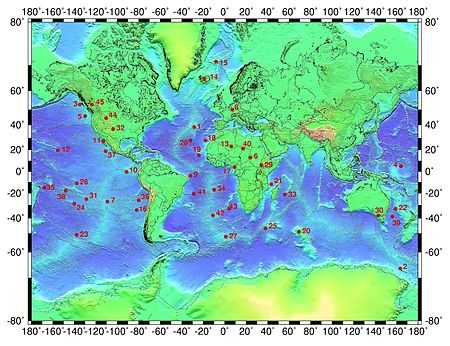
- Paleogene ends 23 million years ago.
- La Garita Caldera erupts in the Wheeler Geologic Area, Central Colorado volcanic field, Colorado, USA, eruption several VEI8 events (Possibly as high as a VEI9), 5,000 cubic kilometers (1,200 cu mi) of Fish Canyon Tuff was blasted out in a major single eruption about 27.8 million years ago.[46][76][77]
- The formation of the Chilcotin Group basalts occurs between 10-6 million years ago.
- The formation of the Columbia River Basalt Group occurs between 17 and 6 million years ago.
- Unknown source in Ethiopia erupts 29 million years ago with at least 3,000 cubic kilometers (720 cu mi) of Green Tuff and SAM.[3]
- Sam Ignimbrite in Yemen forms 29.5 million years ago, at least 5,550 cubic kilometers (1,332 cu mi) of distal tuffs associated with the ignimbrites.[78]
- Jabal Kura’a Ignimbrite in Yemen forms 29.6million years ago, at least 3,700 cubic kilometers (888 cu mi) of distal tuffs associated with the ignimbrites.[78]
- The Ethiopian Highlands flood basalt begins 30 million years ago
- About 33.9 million ago, the Oligocene epoch of the Paleogene period begins
- The Mid-Tertiary ignimbrite flare-up begins 40 million years ago and last till 25 million years ago.
- Bennett Lake Volcanic Complex erupts 50 million years ago with a VEI7 850 cubic kilometers (204 cu mi) of tephra.[79]
- Canary hotspot is believed to have first appeared about 60 million years ago.
- Formation of the Brito-Arctic province begins 61 million years ago.
- Approximately 66 million years ago, the Cretaceous–Paleogene extinction event occurred
- Réunion hotspot, Deccan Traps, India, formed between 60 and 68 million years ago which are thought to have played a role in the K-Pg extinction.
- The Louisville hotspot has produced the Louisville seamount chain, it is active for at least 80 million years. It may have originated the Ontong Java Plateau around 120 million years ago.
- Hawaii hotspot, Meiji Seamount is the oldest extant seamount in the Hawaiian-Emperor seamount chain, with an estimated age of 82 million years.
- The Kerguelen Plateau begins forming 110 million years ago.
- The Rahjamal Traps form from 117-116 million years ago.
- The Ontong Java Plateau forms from 125-120 million years ago
- Paraná and Etendeka traps, Brazil, Namibia and Angola form 128 to 138 million years ago.[80]
- Formation of the Karoo-Ferrar flood basalts begins 183 million years ago.
- The flood basalts of the Central Atlantic magmatic province are thought to have contributed to the Triassic–Jurassic extinction event about 199 million years ago.
- The Siberian Traps are thought to have played a significant role in the Permian–Triassic extinction event 252 million years ago.
- Formation of the Emeishan Traps began 260 million years ago.
- The Late Devonian extinction occurs about 374 million years ago.
- The Ordovician–Silurian extinction event occurs between 450 and 440 million years ago.
- Glen Coe, Scotland; VEI8; 420 million years ago
- Scafells, Lake District, England; VEI8; Ordovician (488.3 - 443.7 million years ago).
- The Phanerozoic eon begins 542 million years ago
- Mackenzie Large Igneous Province forms 1,270 million years ago.
- Mistassini dike swarm and Matachewan dike swarm form 2,500 million years ago.
- Blake River Megacaldera Complex forms 2,704-2,707 million years ago.[79]
- Approximately 2,500 million years ago, the Proterozoic eon of the Precambrian period begins
- About 3,800 million years ago, the Archean eon of the Precambrian period begins
Notes
- The Mackenzie Large Igneous Province contains the largest and best-preserved continental flood basalt terrain on Earth.[81] The Mackenzie dike swarm throughout the Mackenzie Large Igneous Province is also the largest dike swarm on Earth, covering an area of 2,700,000 km2 (1,000,000 sq mi).[82]
- The Bachelor (27.4 Ma), San Luis (27-26.8 Ma), and Creede (26 Ma) calderas partially overlap each other and are nested within the large La Garita (27.6 Ma) caldera, forming the central caldera cluster of the San Juan volcanic field, Wheeler Geologic Area, La Garita Wilderness. Creede, Colorado and San Luis Peak (Continental Divide of the Americas) are nearby. North Pass Caldera is northeastern the San Juan Mountains, North Pass. The Platoro volcanic complex lies southeastern of the central caldera cluster. The center of the western San Juan caldera cluster lies just West of Lake City, Colorado.
- The Rio Grande rift includes the San Juan volcanic field, the Valles Caldera, the Potrillo volcanic field, and the Socorro-Magdalena magmatic system.[83] The Socorro Magma Body is uplifting the surface at approximately 2 mm/year.[84][85]
- The southwestern Nevada volcanic field, or Yucca Mountain volcanic field, includes: Stonewall Mountain caldera complex, Black Mountain Caldera, Silent Canyon Caldera, Timber Mountain - Oasis Valley caldera complex, Crater Flat Group, and Yucca Mountain. Towns nearby: Beatty, Mercury, Goldfield.[86] It is aligned as a Crater Flat volcanic field, Réveille Range, Lunar Crater volcanic field, Zone (CFLC).[87] The Marysvale Volcanic Field, southwestern Utah is nearby too.
- McDermitt volcanic field, or Orevada rift volcanic field, Nevada/ Oregon, nearby are: McDermitt, Trout Creek Mountains, Bilk Creek Mountains, Steens Mountain, Jordan Meadow Mountain (6,816 ft), Long Ridge, Trout Creek, and Whitehorse Creek.
- Emmons Lake stratovolcano (caldera size: 11 x 18 km), Aleutian Range, was formed through six eruptions. Mount Emmons, Mount Hague, and Double Crater are post-caldera cones.[5]
- The topography of the Basin and Range Province is a result of crustal extension within this part of the North American Plate (rifting of the North American craton or Laurentia from Western North America; e.g. Gulf of California, Rio Grande rift, Oregon-Idaho graben). The crust here has been stretched up to 100% of its original width.[88] In fact, the crust underneath the Basin and Range, especially under the Great Basin (includes Nevada), is some of the thinnest in the world.
- Topographically visible calderas: South part of the McDermitt volcanic field (four overlapping and nested calderas), West of McDermitt; Cochetopa Park Caldera, West of the North Pass; Henry's Fork Caldera; Banks Peninsula, New Zealand (Photo) and Valles Caldera. Newer drawings show McDermitt volcanic field (South), as five overlapping and nested calderas. Hoppin Peaks Caldera is included too.
- Repose periods: Toba (0.38 Ma),[34] Valles Caldera (0.35 Ma),[89][90] Yellowstone Caldera (0.7 Ma).[91]
- Kiloannum (ka), is a unit of time equal to one thousand years. Megaannum (Ma), is a unit of time equal to one million years, one can assume that "ago" is implied.
Volcanic Explosivity Index (VEI)
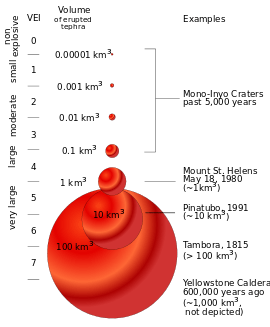
| VEI | Tephra Volume (cubic kilometers) | Example |
|---|---|---|
| 0 | Effusive | Masaya Volcano, Nicaragua, 1570 |
| 1 | >0.00001 | Poás Volcano, Costa Rica, 1991 |
| 2 | >0.001 | Mount Ruapehu, New Zealand, 1971 |
| 3 | >0.01 | Nevado del Ruiz, Colombia, 1985 |
| 4 | >0.1 | Eyjafjallajökull, Iceland, 2010 |
| 5 | >1 | Mount St. Helens, United States, 1980 |
| 6 | >10 | Krakatoa, Indonesia, 1883 |
| 7 | >100 | Mount Tambora, Indonesia, 1815 |
| 8 | >1000 | Yellowstone Caldera, United States, Pleistocene |
Volcanic dimming
The global dimming through volcanism (ash aerosol and sulfur dioxide) is quite independent of the eruption VEI.[92][93][94] When sulfur dioxide (boiling point at standard state: -10°C) reacts with water vapor, it creates sulfate ions (the precursors to sulfuric acid), which are very reflective; ash aerosol on the other hand absorbs Ultraviolet.[95] Global cooling through volcanism is the sum of the influence of the global dimming and the influence of the high albedo of the deposited ash layer.[96] The lower snow line and its higher albedo might prolong this cooling period.[97] Bipolar comparison showed six sulfate events: Tambora (1815), Cosigüina (1835), Krakatoa (1883), Agung (1963), and El Chichón (1982), and the 1809–10 ice core event.[98] And the atmospheric transmission of direct solar radiation data from the Mauna Loa Observatory (MLO), Hawaii (19°32'N) detected only five eruptions:[99]
- June 11, 2009, Sarychev Peak (?), Kuril Islands, 400 tons of tephra, VEI 4
- June 12–15, 1991 (eruptive climax), Mount Pinatubo, Philippines, 11,000 ±0.5 tons of tephra, VEI 6
- Global cooling: 0.5°C,[100] 15°08′0″N 120°21′0″E / 15.13333°N 120.35000°E
- March 28, 1982, El Chichón, Mexico, 2,300 tons of tephra, VEI 5
- October 10, 1974, Volcán de Fuego, Guatemala, 400 tons of tephra, VEI 4
- February 18, 1963, Agung, Lesser Sunda Islands, 100 tons of lava, more than 1,000 tons of tephra, VEI 5
- Northern Hemisphere cooling: 0.3°C,[101]8°20′30″S 115°30′30″E / 8.34167°S 115.50833°E
But very large sulfur dioxide emissions overdrive the oxidizing capacity of the atmosphere. Carbon monoxide's and methane's concentration goes up (greenhouse gases), global temperature goes up, ocean's temperature goes up, and ocean's carbon dioxide solubility goes down.[2]
-
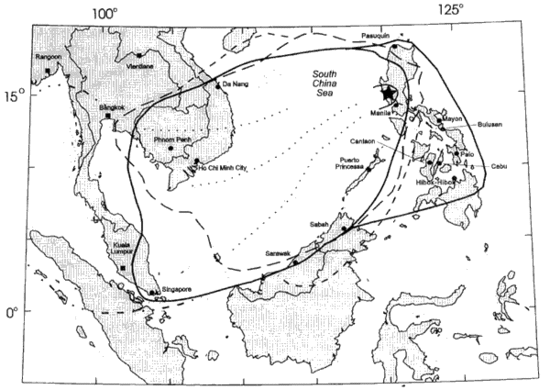
Location of Mount Pinatubo, showing area over which ash from the 1991 eruption fell.
-
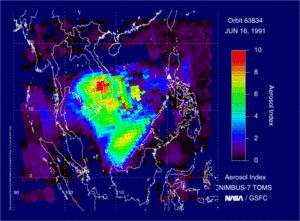
Satellite measurements of ash and aerosol emissions from Mount Pinatubo.
-
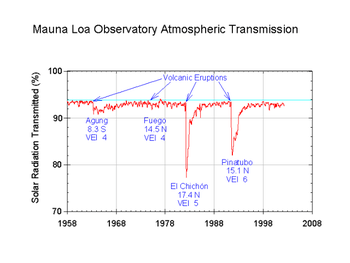
MLO transmission ratio - Solar radiation reduction due to volcanic eruptions
-
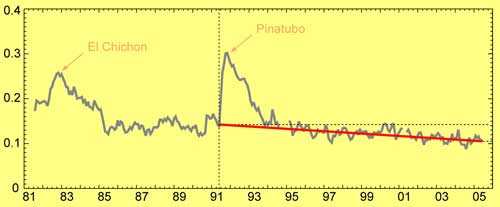
NASA, Global Dimming - El Chichon, VEI 5; Pinatubo, VEI 6.
-
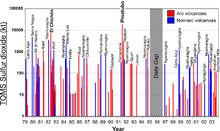
Sulfur dioxide emissions by volcanoes. Mount Pinatubo: 20 million tons of sulfur dioxide.
-
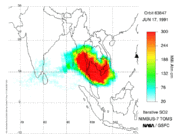
TOMS sulfur dioxide from the June 15, 1991 eruption of Mount Pinatubo.
-
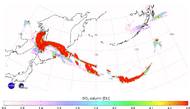
Sarychev Peak: the sulphur dioxide cloud generated by the eruption on June 12, 2009 (in Dobson units).
Map gallery
-
Yellowstone sits on top of four overlapping calderas. (US NPS)
-
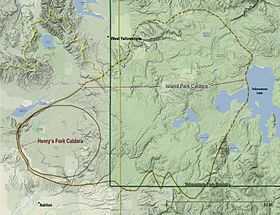
Diagram of Island Park and Henry's Fork Caldera.
-
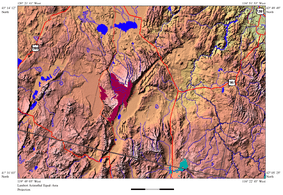
Steens Mountain, McDermitt volcanic field and Oregon/ Nevada stateline.
-
Location of Yellowstone Hotspot in Millions of Years Ago.
-
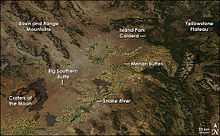
Snake River Plain, image from NASA's Aqua satellite, 2008
-
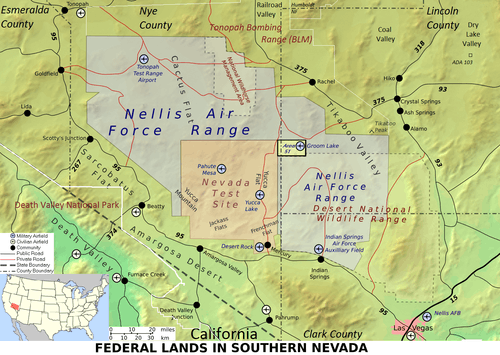
Location of Yucca Mountain in southern Nevada, to the West of the Nevada Test Site.
-
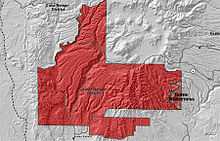
Jemez Ranger District and Jemez Mountains, Santa Fe National Forest.
- ^ Cite error: The named reference
malheurrivergorgewas invoked but never defined (see the help page).
See also
References
- ↑ 1.0 1.1 1.2 Robock, A., C.M. Ammann, L. Oman, D. Shindell, S. Levis, and G. Stenchikov (2009). "Did the Toba volcanic eruption of ~74k BP produce widespread glaciation?". Journal of Geophysical Research 114: D10107. Bibcode:2009JGRD..11410107R. doi:10.1029/2008JD011652.
- ↑ 2.0 2.1 Ward, Peter L. (2 April 2009). "Sulfur Dioxide Initiates Global Climate Change in Four Ways". Thin Solid Films 517 (11): 3188–3203. Bibcode:2009TSF...517.3188W. doi:10.1016/j.tsf.2009.01.005.
- ↑ 3.0 3.1 3.2 3.3 3.4 3.5 3.6 3.7 3.8 3.9 3.10 3.11 3.12 3.13 3.14 3.15 3.16 3.17 3.18 3.19 3.20 3.21 3.22 3.23 3.24 3.25 3.26 3.27 3.28 3.29 3.30 3.31 "Supplementary Table to P.L. Ward, Thin Solid Films (2009) Major volcanic eruptions and provinces". Teton Tectonics. Retrieved 2010-03-16.
- ↑ "International Stratigraphic Chart". International Commission on Stratigraphy. Retrieved 2009-12-23.
- ↑ 5.0 5.1 5.2 5.3 5.4 5.5 5.6 5.7 5.8 5.9 5.10 http://www.volcano.si.edu/world/largeeruptions.cfm Large Holocene Eruptions
- ↑ Brantley, Steven R. (1999-01-04). Volcanoes of the United States. Online Version 1.1. United States Geological Survey. p. 30. ISBN 0-16-045054-3. OCLC 156941033 30835169 44858915. Retrieved 2008-09-12.
- ↑ Judy Fierstein; Wes Hildreth; James W. Hendley II; Peter H. Stauffer (1998). "Can Another Great Volcanic Eruption Happen in Alaska? - U.S. Geological Survey Fact Sheet 075-98". Version 1.0. United States Geological Survey. Retrieved 2008-09-10.
- ↑ Fierstein, Judy; Wes Hildreth (2004-12-11). "The plinian eruptions of 1912 at Novarupta, Katmai National Park, Alaska". Bulletin of Volcanology (Springer) 54 (8): 646. Bibcode:1992BVol...54..646F. doi:10.1007/BF00430778.
- ↑ "Santa Maria". Global Volcanism Program. Smithsonian Institution. Retrieved 2010-03-19.
- ↑ Hopkinson, Deborah (January 2004). "The Volcano That Shook the world: Krakatoa 1883" 11 (4). New York: Storyworks. Scholastic.com. p. 8.
- ↑ http://www.earlham.edu/~ethribe/web/tambora.htm
- ↑ http://www.bris.ac.uk/news/2014/september/unknown-eruption.html
- ↑ BBC Timewatch: "Killer Cloud", broadcast 19 January 2007
- ↑ Sigurdsson Haraldur, Carey S., Mandeville C. (1990). "Assessment of mass, dynamics and environmental effects of the Minoan eruption of the Santorini volcano". Thera and the Aegean World III: Proceedings of the Third Thera Conference II: 100–12.
- ↑ "Huaynaputina". Global Volcanism Program. Smithsonian Institution. Retrieved 2008-12-29.
- ↑ Nemeth, Karoly; Shane J. Cronin; James D.L. White (2007). "Kuwae caldera and climate confusion". The Open Geology Journal 1 (5): 7–11. Bibcode:2007OGJ.....1....7N. doi:10.2174/1874262900701010007.
- ↑ Gao, Chaochao; A. Robock, S. Self, J. B. Witter, J. P. Steffenson, H. B. Clausen, M.-L. Siggaard-Andersen, S. Johnsen, P. A. Mayewski, and C. Ammann (27 June 2006). "The 1452 or 1453 A.D. Kuwae eruption signal derived from multiple ice core records: Greatest volcanic sulfate event of the past 700 years". Journal of Geophysical Research 111: D12107. Bibcode:2006JGRD..11112107G. doi:10.1029/2005JD006710. Retrieved 2010-03-19.
- ↑ Witter, J.B.; Self S. (January 2007). "The Kuwae (Vanuatu) eruption of AD 1452: potential magnitude and volatile release". Bulletin of Volcanology 69 (3): 301–318. Bibcode:2007BVol...69..301W. doi:10.1007/s00445-006-0075-4.
- ↑ Lavigne, Franck (4 September 2013). "Source of the great A.D. 1257 mystery eruption unveiled, Samalas volcano, Rinjani Volcanic Complex, Indonesia". Proceedings of the National Academy of Sciences of the United States of America (PNAS). doi:10.1073/pnas.1307520110. Retrieved 1 October 2013.
- ↑ "Mystery 13th Century eruption traced to Lombok, Indonesia". BBC News. 30 September 2013. Retrieved 1 October 2013.
- ↑ Miller et al. 2012. "Abrupt onset of the Little Ice Age triggered by volcanism and sustained by sea-ice/ocean feedbacks" Geophysical Research Letters 39, January 31
- ↑ Lavigne, Franck et al. (2013). "Source of the great A.D. 1257 mystery eruption unveiled, Samalas volcano, Rinjani Volcanic Complex, Indonesia". PNAS 110 (42): 16742–16747. doi:10.1073/pnas.1307520110.
- ↑ Was the Little Ice Age Triggered by Massive Volcanic Eruptions? ScienceDaily, 30 January 2012 (accessed 21 May 2012)
- ↑ Jiandong
- ↑ Jiandong Xu et al. 2013. "Climatic impact of the Millennium eruption of Changbaishan volcano in China: New insights from high-precision radiocarbon wiggle-match dating" Geophysical Research Letters 40 http://academiccommons.columbia.edu/download/fedora_content/download/ac:162055/CONTENT/XU_et_al_2013_GRL.pdf
- ↑ van den Bogaard, P (1995). 40Ar/(39Ar) ages of sanidine phenocrysts from Laacher See Tephra (12,900 yr BP): Chronostratigraphic and petrological significance
- ↑ de Klerk et al. (2008). Environmental impact of the Laacher See eruption at a large distance from the volcano: Integrated palaeoecological studies from Vorpommern (NE Germany)
- ↑ Baales, Michael; Jöris, Olaf; Street, Martin; Bittmann, Felix; Weninger, Bernhard; Wiethold, Julian (November 2002). "Impact of the Late Glacial Eruption of the Laacher See Volcano, Central Rhineland, Germany". Quaternary Research 58 (3): 273–288. Bibcode:2002QuRes..58..273B. doi:10.1006/qres.2002.2379.
- ↑ Forscher warnen vor Vulkan-Gefahr in der Eifel. Spiegel Online, 13. February 2007. Retrieved January 11, 2008
- ↑ Carey, Steven N.; Sigurdsson, Haraldur (1980). "The Roseau Ash: Deep-sea Tephra Deposits from a Major Eruption on Dominica, Lesser Antilles Arc". Journal of Volcanology and Geothermal Research 7 (1–2): 67–86. Bibcode:1980JVGR....7...67C. doi:10.1016/0377-0273(80)90020-7.
- ↑ Alloway, Brent V.; Agung Pribadi; John A. Westgate; Michael Bird; L. Keith Fifield; Alan Hogg; Ian Smith (30 October 2004). "Correspondence between glass-FT and 14C ages of silicic pyroclastic flow deposits sourced from Maninjau caldera, west-central Sumatra". Earth and Planetary Science Letters (Elsevier) 227 (1–2): 121. Bibcode:2004E&PSL.227..121A. doi:10.1016/j.epsl.2004.08.014.
- ↑ Twickler and K. Taylor, G. A.; Mayewski, P. A.; Meeker, L. D.; Whitlow, S.; Twickler, M. S.; Taylor, K. (1996). "Potential Atmospheric impact of the Toba mega-eruption ~71'000 years ago". Geophysical Research Letters (American Geophysical Union) 23 (8): 837–840. Bibcode:1996GeoRL..23..837Z. doi:10.1029/96GL00706.
- ↑ Jones, S.C. (2007) The Toba supervolcanic eruption: Tephra-fall deposits in India and Paleoanthropological implications; in The evolution and history of human populations in South Asia (eds.) M D Petraglia and B Allchin (New York: Springer Press) pp 173-200
- ↑ 34.0 34.1 Chesner, C.A.; Westgate, J.A.; Rose, W.I.; Drake, R.; Deino, A. (March 1991). "Eruptive History of Earth's Largest Quaternary caldera (Toba, Indonesia) Clarified". Geology 19 (3): 200–203. Bibcode:1991Geo....19..200C. doi:10.1130/0091-7613(1991)019<0200:EHOESL>2.3.CO;2. Retrieved 2010-01-20.
- ↑ Ninkovich, D.; N.J. Shackleton, A.A. Abdel-Monem, J.D. Obradovich, G. Izett (7 December 1978). "K−Ar age of the late Pleistocene eruption of Toba, north Sumatra". Nature (Nature Publishing Group) 276 (276): 574–577. Bibcode:1978Natur.276..574N. doi:10.1038/276574a0.
- ↑ "Guatemala Volcanoes and Volcanics". USGS - CVO. Retrieved 2010-03-13.
- ↑ Cities on Volcanoes 5 conference: A6: Living with Aso-Kuju volcanoes and geothermal field .
- ↑ "Sierra la Primavera". Global Volcanism Program. Smithsonian Institution. Retrieved 2010-03-24.
- ↑ http://gsa.confex.com/gsa/2004AM/finalprogram/abstract_78738.htm
- ↑ Uzon, Global Volcanism Program, Smithsonian Institution
- ↑ Sruoga, Patricia; Eduardo J. Llambías, Luis Fauqué, David Schonwandt and David G. Repol (September 2005). "Volcanological and geochemical evolution of the Diamante Caldera–Maipo volcano complex in the southern Andes of Argentina (34°10′S)". Journal of South American Earth Sciences 19 (4): 399–414. Bibcode:2005JSAES..19..399S. doi:10.1016/j.jsames.2005.06.003.
- ↑ Karlstrom, K.; Crow, R.; Peters, L.; McIntosh, W.; Raucci, J.; Crossey, L.; Umhoefer, P. (2007). "40Ar/39Ar and field studies of Quaternary basalts in Grand Canyon and model for carving Grand Canyon: Quantifying the interaction of river incision and normal faulting across the western edge of the Colorado Plateau". GSA Bulletin 119 (11/12): 1283–1312. Bibcode:2007GSAB..119.1283K. doi:10.1130/0016-7606(2007)119[1283:AAFSOQ]2.0.CO;2.
- ↑ Hildreth, W. (1979), Sarna-Wojcicki et al. (2000).
- ↑ Izett, Glen A. (1981).
- ↑ Heiken et al. (1990).
- ↑ 46.0 46.1 Ben G. Mason; David M. Pyle; Clive Oppenheimer (2004). "The size and frequency of the largest explosive eruptions on Earth". Bulletin of Volcanology (PDF) 66 (8): 735–748. Bibcode:2004BVol...66..735M. doi:10.1007/s00445-004-0355-9.
- ↑ Wood, Charles A.; Jűrgen Kienle (1990). Volcanoes of North America. Cambridge University Press. pp. 170–172.
- ↑ Geological origins, Norfolk Island Tourism. Accessed 2007-04-13.
- ↑ Ort, M. H.; de Silva, S.; Jiminez, N.; Salisbury, M.; Jicha, B. R. and Singer, B. S. (2009). Two new supereruptions in the Altiplano-Puna Volcanic Complex of the Central Andes.
- ↑ Lindsay, Jan M.; Tim J. Worthington; Ian E. M. Smith; Philippa M. Black (June 1999). "Geology, petrology, and petrogenesis of Little Barrier Island, Hauraki Gulf, New Zealand". New Zealand Journal of Geology and Geophysics 42 (2): 155–168. doi:10.1080/00288306.1999.9514837. Retrieved 2007-12-03.
- ↑ Philippe Nonnotte. "Étude volcano-tectonique de la zone de divergence Nord-Tanzanienne (terminaison sud du rift kenyan) – Caractérisation pétrologique et géochimique du volcanisme récent (8 Ma – Actuel) et du manteau source – Contraintes de mise en place thèse de doctorat de l'université de Bretagne occidentale, spécialité : géosciences marines".
- ↑ Lindsay J. M., de Silva S., Trumbull R., Emmermann R., Wemmer K. (2001). "La Pacana caldera, N. Chile: a re-evaluation of the stratigraphy and volcanology of one of the world's largest resurgent calderas". Journal of Volcanology and Geothermal Research 106 (1–2): 145–173. Bibcode:2001JVGR..106..145L. doi:10.1016/S0377-0273(00)00270-5.
- ↑ Frailes Plateau
- ↑ 54.0 54.1 54.2 54.3 54.4 Morgan, Lisa A. Morgan; William C. McIntosh (March 2005). "Timing and development of the Heise volcanic field, Snake River Plain, Idaho, western USA". GSA Bulletin 117 (3–4): 288–306. Bibcode:2005GSAB..117..288M. doi:10.1130/B25519.1. Retrieved 2010-03-16.
- ↑ Geography and Geology, Lord Howe Island Tourism Association. Retrieved on 2009-04-20.
- ↑ "Cerro Panizos". Volcano World. Retrieved 2010-03-15.
- ↑ Te Ara - the Encyclopedia of New Zealand
- ↑ 58.0 58.1 58.2 58.3 58.4 58.5 "Mark Anders: Yellowstone hotspot track". Columbia University, Lamont-Doherty Earth Observatory (LDEO). Retrieved 2010-03-16.
- ↑ Coombs, D. S., Dunedin Volcano, Misc. Publ. 37B, pp. 2–28, Geol. Soc. of N. Z., Dunedin, 1987.
- ↑ Coombs, D. S., R. A. Cas, Y. Kawachi, C. A. Landis, W. F. Mc-Donough, and A. Reay, Cenozoic volcanism in north, east and central Otago, Bull. R. Soc. N. Z., 23, 278–312, 1986.
- ↑ Bishop, D.G., and Turnbull, I.M. (compilers) (1996). Geology of the Dunedin Area. Lower Hutt, NZ: Institute of Geological & Nuclear Sciences. ISBN 0-478-09521-X.
- ↑ Sawyer, David A.; R. J. Fleck, M. A. Lanphere, R. G. Warren, D. E. Broxton and Mark R. Hudson (October 1994). "Episodic caldera volcanism in the Miocene southwestern Nevada volcanic field: Revised stratigraphic framework, 40Ar/39Ar geochronology, and implications for magmatism and extension". Geological Society of America Bulletin 106 (10): 1304–1318. Bibcode:1994GSAB..106.1304S. doi:10.1130/0016-7606(1994)106<1304:ECVITM>2.3.CO;2. Retrieved 2010-03-26.
- ↑ 63.0 63.1 63.2 63.3 63.4 63.5 Lipman, P.W. (September 30, 1984). "The Roots of Ash Flow Calderas in Western North America: Windows Into the Tops of Granitic Batholiths". Journal of Geophysical Research 89 (B10): 8801–8841. Bibcode:1984JGR....89.8801L. doi:10.1029/JB089iB10p08801.
- ↑ Rytuba, James J.; John, David A.; McKee, Edwin H. (May 3–5, 2004). "Volcanism Associated with Eruption of the Steens Basalt and Inception of the Yellowstone Hotspot". Rocky Mountain (56th Annual) and Cordilleran (100th Annual) Joint Meeting. Paper No. 44-2. Retrieved 2010-03-26.
- ↑ 65.0 65.1 65.2 65.3 Steve Ludington, Dennis P. Cox, Kenneth W. Leonard, and Barry C. Moring (1996). Donald A. Singer, ed. "An Analysis of Nevada's Metal-Bearing Mineral Resources". Nevada Bureau of Mines and Geology, University of Nevada
|chapter=ignored (help) - ↑ 66.0 66.1 Rytuba, J.J.; McKee, E.H. (1984). "Peralkaline ash flow tuffs and calderas of the McDermitt Volcanic Field, southwest Oregon and north central Nevada". Journal of Geophysical Research 89 (B10): 8616–8628. Bibcode:1984JGR....89.8616R. doi:10.1029/JB089iB10p08616. Retrieved 2010-03-23.
- ↑ Matthew A. Coble, and Gail A. Mahood (2008). New geologic evidence for additional 16.5-15.5 Ma silicic calderas in northwest Nevada related to initial impingement of the Yellowstone hot spot. Earth and Environmental Science 3 (Collapse Calderas Workshop, IOP Conf. Series). doi:10.1088/1755-1307/3/1/012002. Retrieved 2010-03-23.
- ↑ Carson, Robert J.; Pogue, Kevin R. (1996). Flood Basalts and Glacier Floods:Roadside Geology of Parts of Walla Walla, Franklin, and Columbia Counties, Washington. Washington State Department of Natural Resources (Washington Division of Geology and Earth Resources Information Circular 90).
- ↑ Reidel, Stephen P. (2005). "A Lava Flow without a Source: The Cohasset Flow and Its Compositional Members". Journal of Geology 113 (1): 1–21. Bibcode:2005JG....113....1R. doi:10.1086/425966.
- ↑ Brueseke, M.E.; Heizler, M.T., Hart, W.K., and S.A. Mertzman (15 March 2007). "Distribution and geochronology of Oregon Plateau (U.S.A.) flood basalt volcanism: The Steens Basalt revisited". Journal of Volcanology and Geothermal Research 161 (3): 187–214. Bibcode:2007JVGR..161..187B. doi:10.1016/j.jvolgeores.2006.12.004.
- ↑ SummitPost.org, Southeast Oregon Basin and Range
- ↑ USGS, Andesitic and basaltic rocks on Steens Mountain
- ↑ GeoScienceWorld, Genesis of flood basalts and Basin and Range volcanic rocks from Steens Mountain to the Malheur River Gorge, Oregon
- ↑ "Oregon: A Geologic History. 8. Columbia River Basalt: the Yellowstone hot spot arrives in a flood of fire". Oregon Department of Geology and Mineral Industries. Retrieved 2010-03-26.
- ↑ Cenozoic to Recent plate configurations in the Pacific Basin: Ridge subduction and slab window magmatism in western North America
- ↑ Largest explosive eruptions: New results for the 27.8 Ma Fish Canyon Tuff and the La Garita caldera, San Juan volcanic field, Colorado
- ↑ Olivier Bachmann; Michael A. Dungan; Peter W. Lipman (2002). "The Fish Canyon Magma Body, San Juan Volcanic Field, Colorado: Rejuvenation and Eruption of an Upper-Crustal Batholith". Journal of Petrology 43 (8): 1469–1503. doi:10.1093/petrology/43.8.1469. Retrieved 2010-03-16.
- ↑ 78.0 78.1 Ingrid Ukstins Peate; Joel A. Baker; Mohamed Al-Kadasi; Abdulkarim Al-Subbary; Kim B. Knight; Peter Riisager; Matthew F. Thirlwall; David W. Peate; Paul R. Renne; Martin A. Menzies (2005). "Volcanic stratigraphy of large-volume silicic pyroclastic eruptions during Oligocene Afro-Arabian flood volcanism in Yemen". Bulletin of Volcanology 68 (2): 135–156. Bibcode:2005BVol...68..135P. doi:10.1007/s00445-005-0428-4..
- ↑ 79.0 79.1 Crustal recycling during subduction at the Eocene Cordilleran margin of North America Retrieved on 2007-06-26
- ↑ Sur l'âge des trapps basaltiques (On the ages of flood basalt events); Vincent E. Courtillot & Paul R. Renneb; Comptes Rendus Geoscience; Vol: 335 Issue: 1, January, 2003; pp: 113-140
- ↑ Muskox Property - The Muskox Intrusion
- ↑ The 1.27 Ga Mackenzie Large Igneous Province and Muskox layered intrusion
- ↑ "Westward Migrating Ignimbrite Calderas and a Large Radiating Mafic Dike Swarm of Oligocene Age, Central Rio Grande Rift, New Mexico: Surface Expression of an Upper Mantle Diapir?". New Mexico Tech. Retrieved 2010-03-21.
- ↑ Fialko, Y., and M. Simons, Evidence for on-going inflation of the Socorro magma body, New Mexico, from interferometric synthetic aperture radar imaging Geop. Res. Lett., 28, 3549-3552, 2001.
- ↑ "Socorro Magma Body". New Mexico Tech. Retrieved 2010-03-21.
- ↑ "Figure: Calderas within southwestern Nevada volcanic field". Los Alamos National Laboratory. Retrieved 2010-03-16.
- ↑ Smith, E.I., and D.L. Keenan (30 August 2005). "Yucca Mountain Could Face Greater Volcanic Threat". Eos, Transactions, American Geophysical Union 86 (35). doi:10.1029/2005eo350001. Retrieved 1/3/09. Check date values in:
|accessdate=(help) - ↑ Geologic Provinces of the United States: Basin and Range Province on USGS.gov website Retrieved 9 November 2009
- ↑ Doell, R.R., Dalrymple, G.B., Smith, R.L., and Bailey, R.A., 1986, Paleomagnetism, potassium-argon ages, and geology of rhyolite and associated rocks of the Valles Caldera, New Mexico: Geological Society of America Memoir 116, p. 211-248.
- ↑ Izett, G.A., Obradovich, J.D., Naeser, C.W., and Cebula, G.T., 1981, Potassium-argon and fission-track ages of Cerro Toledo rhyolite tephra in the Jemez Mountains, New Mexico, in Shorter contributions to isotope research in the western United States: U.S. Geological Survey Professional Paper 1199-D, p. 37-43.
- ↑ Christiansen, R.L., and Blank, H.R., 1972, Volcanic stratigraphy of the Quaternary rhyolite plateau in Yellowstone National Park: U.S. Geological Survey Professional Paper 729-B, p. 18.
- ↑ Salzer, Matthew W.; Malcolm K. Hughes (2007). "Bristlecone pine tree rings and volcanic eruptions over the last 5000 yr". Quaternary Research 67: 57–68. Bibcode:2007QuRes..67...57S. doi:10.1016/j.yqres.2006.07.004. Retrieved 2010-03-18.
- ↑ "VEI glossary entry". USGS. Retrieved 2010-03-30.
- ↑ "Volcanic Sulfur Aerosols Affect Climate and the Earth's Ozone Layer - Volcanic ash vs sulfur aerosols". U.S. Geological Survey. Retrieved 2010-04-21.
- ↑ http://earthobservatory.nasa.gov/IOTD/view.php?id=38975 Earth Observatory - Sarychev Eruption
- ↑ Jones, M.T., Sparks, R.S.J., and Valdes, P.J. (2007). "The climatic impact of supervolcanis ash blankets". Climate Dynamics 29 (6): 553–564. Bibcode:2007ClDy...29..553J. doi:10.1007/s00382-007-0248-7.
- ↑ Jones, G.S., Gregory, J.M., Scott, P.A., Tett, S.F.B., Thorpe, R.B., 2005. An AOGCM model of the climate response to a volcanic super-eruption. Climate Dynamics 25, 725-738
- ↑ Dai, Jihong; Ellen Mosley-Thompson and Lonnie G. Thompson (1991). "Ice core evidence for an explosive tropical volcanic eruption six years preceding Tambora". Journal of Geophysical Research (Atmospheres) 96 (D9): 17,361–17,366. doi:10.1029/91jd01634.
- ↑ http://www.esrl.noaa.gov/gmd/grad/mloapt.html Atmospheric transmission of direct solar radiation (Preliminary) at Mauna Loa, Hawaii
- ↑ "Mt. Pinatubo's cloud shades global climate". Science News. Retrieved 2010-03-07.
- ↑ Jones, P.D., Wigley, T.M.I, and Kelly, P.M. (1982), Variations in surface air temperatures: Part I. Northern Hemisphere, 1881-1980: Monthly Weather Review, v.110, p. 59-70.
Further reading
- Ammann, Caspar M.; Philippe Naveau (6 March 2003). "Statistical analysis of tropical explosive volcanism occurrences over the last 6 centuries". Geophysical Research Letters 30 (5): 1210. Bibcode:2003GeoRL..30e..14A. doi:10.1029/2002GL016388. Retrieved 2010-03-19.
- Froggatt, P.C.; Lowe, D.J. (1990). "A review of late Quaternary silicic and some other tephra formations from New Zealand: their stratigraphy, nomenclature, distribution, volume, and age". New Zealand Journal of Geology and Geophysics 33: 89–109. doi:10.1080/00288306.1990.10427576. Retrieved 2010-03-19.
- Lipman, P.W. (September 30, 1984). "The Roots of Ash Flow Calderas in Western North America: Windows Into the Tops of Granitic Batholiths". Journal of Geophysical Research 89 (B10): 8801–8841. Bibcode:1984JGR....89.8801L. doi:10.1029/JB089iB10p08801.
- Mason, Ben G.; Pyle, David M.; Oppenheimer, Clive (2004). "The size and frequency of the largest explosive eruptions on Earth". Bulletin of Volcanology 66 (8): 735–748. Bibcode:2004BVol...66..735M. doi:10.1007/s00445-004-0355-9.
- Newhall, Christopher G., Dzurisin, Daniel (1988); Historical unrest at large calderas of the world, USGS Bulletin 1855, p. 1108
- Siebert L., and Simkin T. (2002-). Volcanoes of the World: an Illustrated Catalog of Holocene Volcanoes and their Eruptions. Smithsonian Institution, Global Volcanism Program, Digital Information Series, GVP-3, (http://www.volcano.si.edu/world/).
- Simkin T., and Siebert L. (1994). Volcanoes of the World. Geoscience Press, Tucson, 2nd edition. p. 349. ISBN 0-945005-12-1.
- Simkin T., and Siebert L. (2000). Sigurdsson H., ed. "Encyclopedia of Volcanoes". San Diego: Academic Press. pp. 249–261
|chapter=ignored (help) - Simkin, T.; Siebert L.; McClelland L.; Bridge D.; Newhall C.; Latter J.H. (1981). Volcanoes of the World: A Regional Directory, Gazeteer, and Chronology of Volcanism During the Last 10,000 Years. Hutchinson-Ross, Stroudsburg, Pennsylvania. p. 232. ISBN 0-87933-408-8.
- Stern, Charles R. (December 2004). "Active Andean volcanism: its geologic and tectonic setting". Revista Geológica de Chile 31 (2): 161–206. doi:10.4067/S0716-02082004000200001. Retrieved 2010-03-17.
- United States Geological Survey; Cascades Volcano Observatory, Vancouver, Washington; Index to CVO online volcanoes
- Map: Tom Simkin, Robert I. Tilling, Peter R. Vogt, Stephen H. Kirby, Paul Kimberly, and David B. Stewart, Third Edition (Published 2006) interactive world map of Volcanoes, Earthquakes, Impact Craters, and Plate Tectonics
- Ward, Peter L. (2 April 2009). "Sulfur Dioxide Initiates Global Climate Change in Four Ways". Thin Solid Films 517 (11): 3188–3203. Bibcode:2009TSF...517.3188W. doi:10.1016/j.tsf.2009.01.005. Retrieved 2010-03-19.
- Supplementary Table I: "Supplementary Table to P.L. Ward, Thin Solid Films (2009) Major volcanic eruptions and provinces". Teton Tectonics. Retrieved 2010-03-16.
- Supplementary Table II: "Supplementary References to P.L. Ward, Thin Solid Films (2009)". Teton Tectonics. Retrieved 2010-03-16.
External links
- Volcano World Information
- Volcano Live, John Seach
- Volcanoes in Nicaragua
- Holocene Volcanoes in Kamchatka
- National Park Service interactive map showing trace of the hotspot over time
- Reference Database of the International Association of Volcanology (XLS file)
- Reference Database of Chemistry of the Earth’s Interior (XLS file)
- Volcanic sulfate record in the GISP2 core (ftp protocol)
| ||||||||||

